-
Friends, our 2nd Amendment rights are always under attack and the NRA has been a constant for decades in helping fight that fight.
We have partnered with the NRA to offer you a discount on membership and Muzzleloading Forum gets a small percentage too of each membership, so you are supporting both the NRA and us.
Use this link to sign up please; https://membership.nra.org/recruiters/join/XR045103
You are using an out of date browser. It may not display this or other websites correctly.
You should upgrade or use an alternative browser.
You should upgrade or use an alternative browser.
Barn Gun?
- Thread starter talon
- Start date

Help Support Muzzleloading Forum:
This site may earn a commission from merchant affiliate
links, including eBay, Amazon, and others.
Cody,So, would a cooey/winchester single shot .22 be the more modern equivilent to a barn gun?.
Here is a Winchester 1890 built in 1919 I'm almost 100% sure it was a barn gun and spent its whole life in a dirty barn or shed. I bought it in Lancaster Co., PA and it was filthy, heavily pitted and corroded, but fully functional and original. Not pretty by any means but I bought is dirt cheap and it has its own charm.

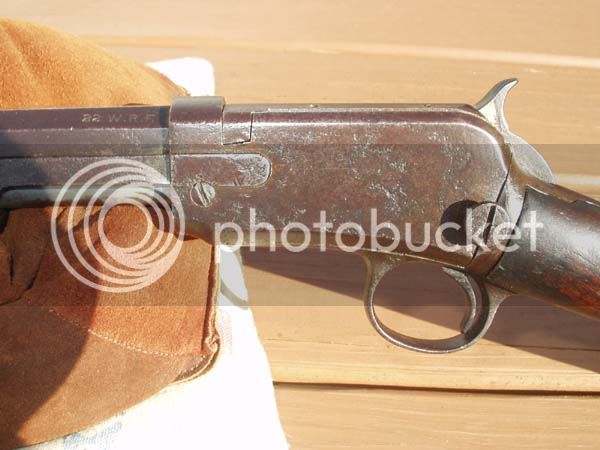
there was nothing ''taken'' away from a schimmel. they were stocked in the same maple that the builder would have used for his finer rifles. more than likely a rifled barrel and a fine quality lock.
these were the working guns of the every day man. the fancy carving and brass furniture had no place on these. those features were costly and un-needed items to put meat on teh table and defeat the home.
few of these guns survived the years, as they were the working gun, not the shiney wall hanger that survived the decades and centuries.
often a second or backup gun in addition to being the every day rifle.
these were the working guns of the every day man. the fancy carving and brass furniture had no place on these. those features were costly and un-needed items to put meat on teh table and defeat the home.
few of these guns survived the years, as they were the working gun, not the shiney wall hanger that survived the decades and centuries.
often a second or backup gun in addition to being the every day rifle.
That's exactly the kind of weapon of which I was thinking... a strong functional piece that's made to bring home the food at the end of the day (or serve just as servicably in a fight).
So what kind of metal would you see on such a rifle? I've read that one of the reasons for iron in the southern mountain rifles was that brass was far more scarce than it was through the northern colonies... I was just thinking, a basic solid barrel and lock with an unadorned stock of quality wood (possibly in "Bedford County" style, but I haven't really sat down and looked at dates yet), fitted with some simple brass strikes me as being far closer to the reality of what the everyday rifle would be "out west" in Fayette or Somerset counties of PA...
It just seems to me that there's more to the schimmel or 'barn gun' than I've read (although I'm admittedly an uber-novice)!
So what kind of metal would you see on such a rifle? I've read that one of the reasons for iron in the southern mountain rifles was that brass was far more scarce than it was through the northern colonies... I was just thinking, a basic solid barrel and lock with an unadorned stock of quality wood (possibly in "Bedford County" style, but I haven't really sat down and looked at dates yet), fitted with some simple brass strikes me as being far closer to the reality of what the everyday rifle would be "out west" in Fayette or Somerset counties of PA...
It just seems to me that there's more to the schimmel or 'barn gun' than I've read (although I'm admittedly an uber-novice)!
Geoff Jones
40 Cal.
- Joined
- Jun 6, 2005
- Messages
- 104
- Reaction score
- 0
Hey,
If you go to Eric Kettenburg's website,[url] www.erickettenburg.com[/url], open the site, got to the bottom and click on "online articles"....follow the link for "thoughts on plain firearms of the 18th century...you'll find a world of information on "barn guns". In case you're not familiar with Eric's work....he's one of the finest builders out there today. Be sure to check out his work in the "Photo Index" section
If you go to Eric Kettenburg's website,[url] www.erickettenburg.com[/url], open the site, got to the bottom and click on "online articles"....follow the link for "thoughts on plain firearms of the 18th century...you'll find a world of information on "barn guns". In case you're not familiar with Eric's work....he's one of the finest builders out there today. Be sure to check out his work in the "Photo Index" section
Last edited by a moderator:
That was a very good article, thank you for passing it along. The last rifle pictured is exactly the kind of weapon of which I was thinking... the middle of the road rifle that would have still been quite costly but would also not have been quite in the same league as the 'show peices'.
Geoff Jones
40 Cal.
- Joined
- Jun 6, 2005
- Messages
- 104
- Reaction score
- 0
SnaitN,
That's a great website for info, heh?
That's a great choice in weapons...elegant in it's Lehigh Valley shape and origin, yet simplistic and very appealing.
I'd choose a rather plain maple or perhaps a cherry stock for that gun and concentrate on great architecture and fit and finish....not carving and engraving.
Bill Shipman did an outstanding job on just such a weapon...look on his website,[url] http://www.billshipman.com/[/url]
Then go to the "madder root Lehigh"
Just outstanding in it's beauty and simplicity
geoff
That's a great website for info, heh?
That's a great choice in weapons...elegant in it's Lehigh Valley shape and origin, yet simplistic and very appealing.
I'd choose a rather plain maple or perhaps a cherry stock for that gun and concentrate on great architecture and fit and finish....not carving and engraving.
Bill Shipman did an outstanding job on just such a weapon...look on his website,[url] http://www.billshipman.com/[/url]
Then go to the "madder root Lehigh"
Just outstanding in it's beauty and simplicity
geoff
Last edited by a moderator:
i got a glimps of it in my mind a second ago.. when someone mentioned always smoothbore... picture an old gun kept in the wagon, or barn or porch, always loaded, never cleaned, just shot, then loaded,.. we have crops to farm and we dont need to be cleaning guns all the time.. .. even if it did have rifling a couple generations ago, it doesnt now.. woops haloween tomorow night, need to put some rock salt in the barn gun... last year grannie shot the coon in the garbage can with the rock salt whilst i was having a drink at the bar, and she reloaded it, and i shot the neighbor kid in the butt with number six.. oh well *&%$ happens... thats seemed to work out ok, i havnt seen him for about a year... :hmm: dave..
Goldhunter
54 Cal.
- Joined
- Mar 27, 2006
- Messages
- 1,596
- Reaction score
- 6
While not a barn gun, I really like that Early Reading rifle (bottom of his gallery) on Bill's site as a"middle of the road" rifle. That is the rifle I would like to make, no grand carving and not much brass, just simple. I don't even think I would put any carving around the cheek piece, just some simple molding along the bottom.
Great site, thanks for suggesting.
Great site, thanks for suggesting.
Both links have been fantastic resources!! I'm doing the preliminary footwork on what I want to build as my first long rifle and I'm really gravitating towards a far more "plain Jane" rifle such as we've seen here.
Not only would it be far less likely for me to drastically screw something up, but also it would suit the region of Pennsylvania from which I hail.
Offhand, has anyone read "The Longrifles of Western Pennsylvania: Allegheny and Westmoreland Counties"? I'd like to find someone who's actually read it before buying, but I'm likely going to buy a copy anyway... it's from a Pitt professor, published in '93.
My overall goal is to build a rifle that would be at home in the mountains of Fayette or Somerset County Pennsylvania (west of Bedford, South of Allegheny), which to me calls for a less intricate weapon such as I've just seen on these two sites! I'm thinking brass fittings and butt plate (without toe piece) with a simple side plate and little to no decorative carving (and likely without patch box, seems to me that the patch box would have added a lot of time and cost to the final product). I'm looking for as many examples of these "middle of the road" rifles as I can find, so if anyone has anything... suggestions, comments, pictures, even "Hey, you're a frickin idiot, you're barking up the wrong tree and don't know what you're talking about"'s, please post! What do you guys think though, all in all? Does this seem like a plausible or worthy goal?
Not only would it be far less likely for me to drastically screw something up, but also it would suit the region of Pennsylvania from which I hail.
Offhand, has anyone read "The Longrifles of Western Pennsylvania: Allegheny and Westmoreland Counties"? I'd like to find someone who's actually read it before buying, but I'm likely going to buy a copy anyway... it's from a Pitt professor, published in '93.
My overall goal is to build a rifle that would be at home in the mountains of Fayette or Somerset County Pennsylvania (west of Bedford, South of Allegheny), which to me calls for a less intricate weapon such as I've just seen on these two sites! I'm thinking brass fittings and butt plate (without toe piece) with a simple side plate and little to no decorative carving (and likely without patch box, seems to me that the patch box would have added a lot of time and cost to the final product). I'm looking for as many examples of these "middle of the road" rifles as I can find, so if anyone has anything... suggestions, comments, pictures, even "Hey, you're a frickin idiot, you're barking up the wrong tree and don't know what you're talking about"'s, please post! What do you guys think though, all in all? Does this seem like a plausible or worthy goal?
"The Longrifles of Western Pennsylvania: Allegheny and Westmoreland Counties" is a beautiful book and the photos would bring tears to the eyes of the most prolific builder.
There are no "barn guns" in this book however, there is quite a bit of information about the builders in that area of Pennsylvania.
This is the only book I repeatedly checked out of the Phoenix library and when I saw a copy for sale at a local Used Book Dealer, I snatched it up.
zonie
There are no "barn guns" in this book however, there is quite a bit of information about the builders in that area of Pennsylvania.
This is the only book I repeatedly checked out of the Phoenix library and when I saw a copy for sale at a local Used Book Dealer, I snatched it up.
zonie
Wow, thank you very much for the review. I'm going to try to find a used copy of it online before ponying up the sixty bucks for the hardback on Amazon... It mostly interests me because it's the only thing I've found as of yet (granted, I haven't been researching long at all) that highlights weapons crafted in the general area where I'm from.
While it doesn't exactly sound like I'll find much to emulate in any future "middle of the road" style rifle, perhaps there may be traits from south west PA's schools of design that may not necessarily be present in the work of 'smiths farther east? That was my mindset, but mostly I'm a sucker for purty pictures!!!
While it doesn't exactly sound like I'll find much to emulate in any future "middle of the road" style rifle, perhaps there may be traits from south west PA's schools of design that may not necessarily be present in the work of 'smiths farther east? That was my mindset, but mostly I'm a sucker for purty pictures!!!
This is one of the picture from that book.
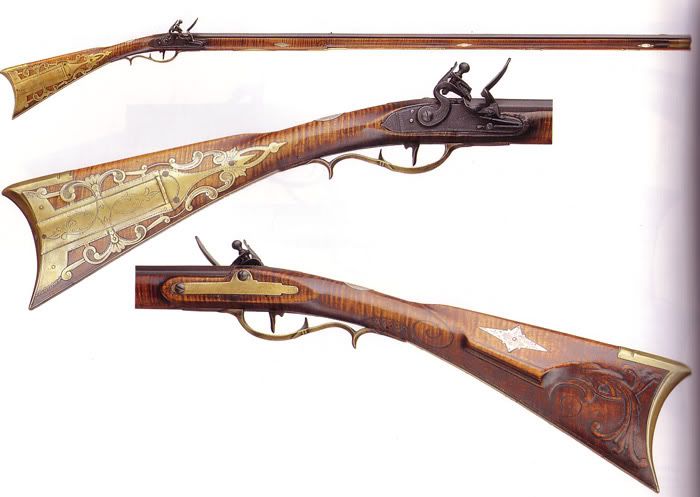
As I said, they aren't very plain, but you can use the pictures to determine what the proper architecture and furniture should be.
zonie

As I said, they aren't very plain, but you can use the pictures to determine what the proper architecture and furniture should be.
zonie
Guest
Here's a relatively plain Lehigh
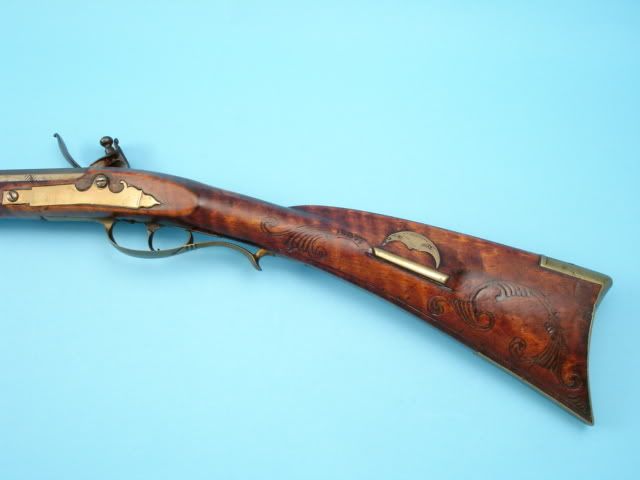
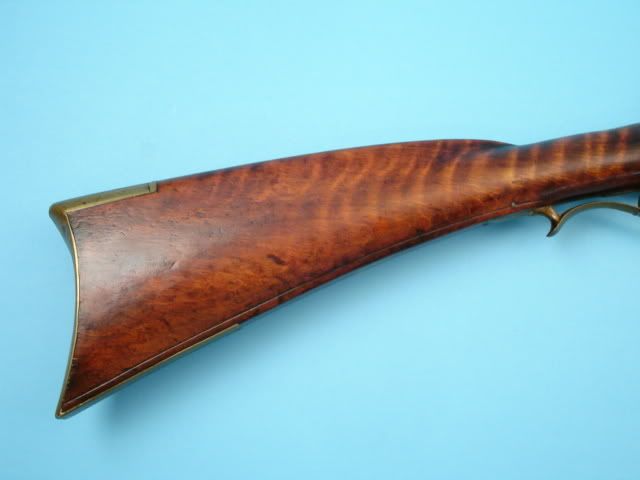
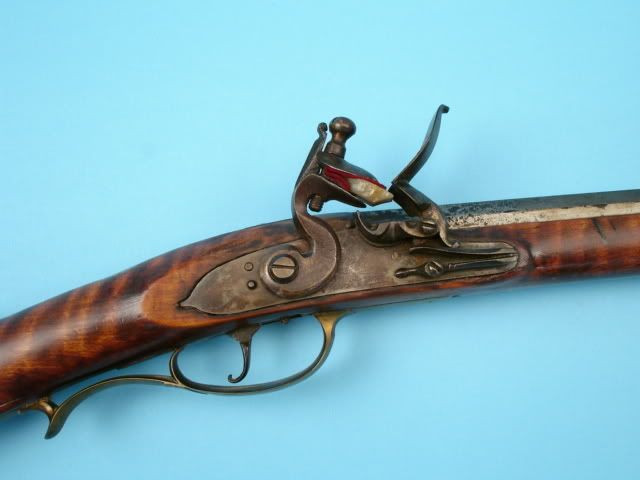
Maker is Samual Baum. I'm in the process of trying to make a copy of it. It'll be a .45 cal Swamped rice barrel, with a late Ketland Chambers lock, with maple stock. I've been able to make a scale drawing by scaling the pictures, and using the lock dimension to verify the size. It's not overly decorated, just some light incise carving behind the cheek piece, and at the wrist on the one side, with the moon inlay on the cheek, and some plain half moon escutheons for the barrel pins, with plain thimbles, and nosepiece. There's no patchbox. Probably about 1820 or so.
Bill



Maker is Samual Baum. I'm in the process of trying to make a copy of it. It'll be a .45 cal Swamped rice barrel, with a late Ketland Chambers lock, with maple stock. I've been able to make a scale drawing by scaling the pictures, and using the lock dimension to verify the size. It's not overly decorated, just some light incise carving behind the cheek piece, and at the wrist on the one side, with the moon inlay on the cheek, and some plain half moon escutheons for the barrel pins, with plain thimbles, and nosepiece. There's no patchbox. Probably about 1820 or so.
Bill
That is right along the lines of what I was thinking! Nice quality maple stock with some small level of brass accents and carving... I really like the look of that weapon.
I think my next step is definately to get the book from Pitt press to look at some SW PA rifles... and begin my scheming!! I'm going to begin sketching up some basic designs within the next month or so, then start on some practice carving for the next couple of months... I figure by the middle of winter I'll be ready to start working.
Does anyone have any other suggestions for information and resources regarding rifles from SW PA (Bedford County and west into Somerset, Fayette, Allegheny)?
I think my next step is definately to get the book from Pitt press to look at some SW PA rifles... and begin my scheming!! I'm going to begin sketching up some basic designs within the next month or so, then start on some practice carving for the next couple of months... I figure by the middle of winter I'll be ready to start working.
Does anyone have any other suggestions for information and resources regarding rifles from SW PA (Bedford County and west into Somerset, Fayette, Allegheny)?
Guest
I would also recommend you get some books on building. "The Gunsmith of Grenville County" by Alexander will give you most of the building info you need. It's avaiable from Track, and some other suppliers. You will also need to look at the tools you need, most of which are hand tools. About the only power tool you will need would be a drill press. If you are going to use a swampede barrel, I would buy the stock and barrel, and pre-inlet together from the same supplier, for ease of fit.
Bill
Bill
Yes, I should have listed a couple of construction books as well, that's a given... no way I'd go into something as in-depth as this without a LOAD of background information! I've done a good bit of work on gun stocks in the past, done some customizing, chopping and reshaping, refinishing and the like... but this will be my first ground-up build.
Well, I just placed an order for "The Gunsmith of Grenville County" and "The Longrifles of Western Pennsylvania: Allegheny and Westmoreland Counties" used through Amazon... I figure I'll have some reading material for the next few months while I practice the assorted skills I'm going to need to do a passable job of rifle construction.
What other reading material would you suggest to give a strong referance background for a long rifle construction project?
What other reading material would you suggest to give a strong referance background for a long rifle construction project?
Similar threads
- Replies
- 3
- Views
- 215
- Replies
- 6
- Views
- 444
- Replies
- 9
- Views
- 395




